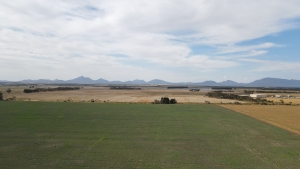
A new Grains Research and Development Corporation (GRDC) investment aims to provide grain growers in southern Western Australia with a range of spring and summer cropping options to explore production opportunities as well as address the impacts of excessive winter waterlogging.
The project, led by Stirlings to Coast Farmers (SCF), is of particular relevance to growers in the medium to high rainfall zones of the lower Central Wheatbelt, Great Southern and South Coastal regions of WA where excessive waterlogging occurred during the 2021 season.
SCF chief executive Nathan Dovey says the 18-month project, which has now commenced, aims to improve the knowledge and confidence of growers to profitably sow a crop in spring or summer on paddocks where winter crops or pastures have failed due to waterlogging or where soil moisture levels permit.
“It’s about converting rainfall into something profitable,” Mr Dovey says.
“Unlike years ago, we now have the plants to work with – we just need to improve our understanding of how they fit into our farming systems for the greatest impact.”
The project will establish three multi-species validation spring and/or summer sown field trials at Jerramungup, Boyup Brook and Green Range.
Each validation trial will have at least three treatments as well as a ‘standard grower practice’ control. Where possible, at least one cereal, brassica and legume will be sown to analyse which species provides the best option under differing conditions for a spring sown crop.
Assessments will evaluate weed numbers, pest pressure and management, plant available soil moisture, soil nutrition and erosion control over summer, and the overall productivity of the spring sown crops and following winter sown crops.
“There will also be four single species grain crop demonstrations located at South Stirlings, Mobrup, Wickepin and Lake Cairlocup,” Mr Dovey says.
“The grower groups will be measuring the productivity of winter canola, winter wheat and sorghum.”

In addition to the farm-scale demonstrations, a summer grains small plot trial will be conducted by Nutrien Ag Solutions. This is a replicated and randomised exploratory trial that aims evaluate the viability of a range crop types to be sown in the spring.
“Overall, the project will be local grower and adviser driven so that solutions demonstrated in the field are both practical and locally relevant,” Mr Dovey says.
“Practicalities such as access to seed, seeder/harvester set-up and grain quality, drying and marketability are also being considered as part of the research.
“All costs and potential profits will be factored into reporting to ascertain the true value of this rotational tool to the farming system,” Mr Dovey says.

Case studies will be developed about growers who have planted either an August or September-sown fast maturing winter crop, spring-sown summer crop or a summer crop after winter crop harvest to evaluate their experiences and the profitability of their management decision.
Summer crops are not new to the south coast of WA, having been grown with varying degrees of success for more than 50 years.
Previous GRDC investment has found summer forage crops to be successful, not only due to the summer/autumn livestock grazing opportunity presented but also, in some cases, by reducing recharge (delaying onset of salinity) and successfully providing nitrogen to the following winter crop where a summer legume has been sown.
GRDC Grower Relations Manager – West, Lizzie von Perger, says the ‘Locally relevant spring and/or summer sown cropping opportunities for grain growers following excessive winter waterlogging – South-Western Australia’ initiative will validate previous research and development investment outcomes relating to spring sown crops at a local level, but will also include newer crop types and varieties, that were previously not available.
“It will build local grower and adviser knowledge to inform decisions when managing excess soil moisture,” Ms von Perger said.
“The project will focus on the key management aspects raised by growers at the GRDC’s 2021 winter ³Ô¹ÏÍøÕ¾ Grower Network meetings – namely weed and erosion control in waterlogged areas, making use of the excess water to produce additional grain and/or forage, and understanding impacts on the following winter crop, such as soil moisture/salt levels, root architecture and biomass, as well as soil nutrient levels and distribution.”








